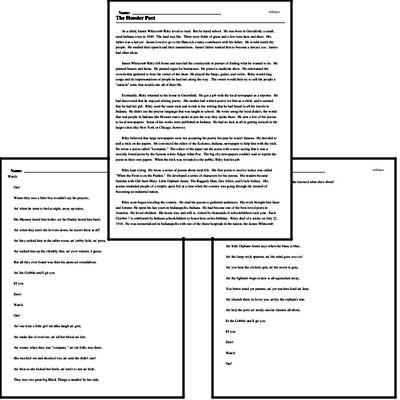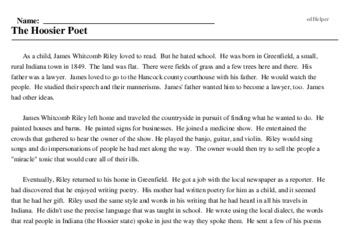The Hoosier Poet
James Whitcomb Riley
Reading Comprehension for October 7
As a child, James Whitcomb Riley loved to read. But he hated school. He was born in Greenfield, a small, rural Indiana town in 1849. The land was flat. There were fields of grass and a few trees here and there. His father was a lawyer. James loved to go to the Hancock county courthouse with his father. He would watch the people. He studied their speech and their mannerisms. James' father wanted him to become a lawyer, too. James had other ideas.
James Whitcomb Riley left home and traveled the countryside in pursuit of finding what he wanted to do. He painted houses and barns. He painted signs for businesses. He joined a medicine show. He entertained the crowds that gathered to hear the owner of the show. He played the banjo, guitar, and violin. Riley would sing songs and do impersonations of people he had met along the way. The owner would then try to sell the people a "miracle" tonic that would cure all of their ills.
Eventually, Riley returned to his home in Greenfield. He got a job with the local newspaper as a reporter. He had discovered that he enjoyed writing poetry. His mother had written poetry for him as a child, and it seemed that he had her gift. Riley used the same style and words in his writing that he had heard in all his travels in Indiana. He didn't use the precise language that was taught in school. He wrote using the local dialect, the words that real people in Indiana (the Hoosier state) spoke in just the way they spoke them. He sent a few of his poems to local newspapers. Some of his works were published in Indiana. He had no luck at all in getting noticed in the larger cities like New York or Chicago, however.
Riley believed that large newspapers were not accepting his poetry because he wasn't famous. He decided to pull a trick on the papers. He convinced the editor of the Kokomo, Indiana, newspaper to help him with the trick. He wrote a poem called "Leonainie." The editor of the paper ran the poem with a story saying that it was a recently found poem by the famous writer, Edgar Allan Poe. The big city newspapers couldn't wait to reprint the poem in their own papers. When the trick was revealed to the public, Riley lost his job.
Riley kept trying. He wrote a series of poems about rural life. His first poem to receive notice was called "When the Frost is on the Punkin." He developed a series of characters for his poems. His readers became familiar with Old Aunt Mary, Little Orphant Annie, The Raggedy Man, Doc Sifers, and Uncle Sidney. His poems reminded people of a simple, quiet life at a time when the country was going through the turmoil of becoming an industrial nation.
Riley soon began traveling the country. He read his poems to gathered audiences. His work brought him fame and fortune. He spent his last years in Indianapolis, Indiana. He had become one of the best-loved poets in America. He loved children. His home was, and still is, visited by thousands of schoolchildren each year. Each October 7 is celebrated by Indiana schoolchildren to honor him on his birthday. Riley died of a stroke on July 22, 1916. He was memorialized in Indianapolis with one of the finest hospitals in the nation, the James Whitcomb Riley Hospital for Children.
Following is one of Riley's most famous poems, "Little Orphant Annie." At its beginning is the original dedication Riley made for the poem.
Little Orphant Annie
By James Whitcomb Riley
To all the little children: The happy ones; and sad ones;
The sober and the silent ones; the boisterous and glad ones;




